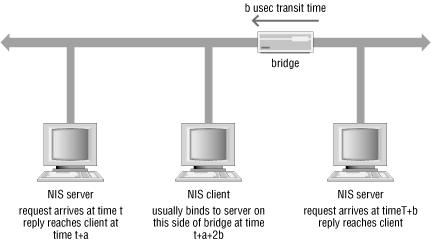Impact of partitioning
Although partitioning is a solution to many network problems, it's not entirely transparent. When you partition a network, you must think about the effect of partitioning on NIS, and the locations of diskless nodes and their boot servers.
NIS in a partitioned network
NIS is a point-to-point protocol once a server binding has been established. However, when ypbind searches for a server, it broadcasts an RPC request. Switches and bridges do not affect ypbind, because switches and bridges forward broadcast packets to the other physical network. Routers don't forward broadcast packets to other IP networks, so you must make configuration exceptions if you have NIS clients but no NIS server on one side of a router.It is not uncommon to attach multiple clients to a hub, and multiple hubs to a switch. Each switch branch acts as its own segment in the same way that bridges create separate "collision domains." Unequal distribution of NIS servers on opposite sides of a switch branch (or bridge) can lead to server victimization. The typical bridge adds a small delay to the transit time of each packet, so ypbind requests will almost always be answered by a server on the client's side of the switch branch or bridge. The relative delays in NIS server response time are shown in Figure 17-2. 
Figure 17-2. Bridge effects on NIS
If there is only one server on bridge network A, but several on bridge network B, then the "A" network server handles all NIS requests on its network segment until it becomes so heavily loaded that servers on the "B" network reply to ypbind faster, including the bridge-related packet delay. An equitable distribution of NIS servers across switch branch (or bridge) boundaries eliminates this excessive loading problem.Routers and gateways present a more serious problem for NIS. NIS servers and clients must be on the same IP network because a router or gateway will not forward the client's ypbind broadcast outside the local IP network. If there are no NIS servers on the "inside" of a router, use ypinit at configuration time as discussed in "Setting initial client bindings".
Effects on diskless nodes
Diskless nodes should be kept on the same logical network as their servers unless tight constraints require their separation. If a router is placed between a diskless client and its server, every disk operation on the client, including swap device operations, has to go through the router. The volume of traffic generated by a diskless client is usually much larger -- sometimes twice as much -- than that of an NFS client getting user files from a server, so it greatly reduces the load on the router if clients and servers are kept on the same side of the router.[53]
[53]Although not directly related to network topology, one of the best things you can do for your diskless clients is to load them with an adequate amount of memory so that they can perform aggressive caching and reduce the number of round trips to the server.
Booting a client through a router is less than ideal, since the diskless client's root and swap partition traffic unnecessarily load the packet forwarding bandwidth of the router. However, if necessary, a diskless client can be booted through a router as follows:
- Some machine on the client's local network must be able to answer Reverse ARP (RARP) requests from the machine. This can be accomplished by publishing an ARP entry for the client and running in.rarpd on some host on the same network:
in.rarpd hme 0
In Solaris, in.rarpd takes the network device name and the instance number as arguments. In this example we start in.rarpd on /dev/hme0, the network interface attached to the diskless client's network. in.rarpd uses the ethers, hosts, and ipnodes databases[54] to map the requested Ethernet address into the corresponding IP address. The IP address is then returned to the diskless client in a RARP reply message. The diskless client must be listed in both databases for in.rarpd to locate its IP address.
[54]The ethers database is stored in the local file /etc/ethers or the corresponding NIS map. The hosts and ipnodes database is located in the local files /etc/inet/hosts and /etc/inet/ipnodes, or DNS and NIS maps. The search order depends on the contents of the name switch configuration file /etc/nsswitch.conf.
- A host on the local network must be able to tftp the boot code to the client, so that it can start the boot sequence. This usually involves adding client information to /tftpboot on another diskless client server on the local network.
- Once the client has loaded the boot code, it looks for boot parameters. Some server on the client's network must be able to answer the bootparams request for the client. This entails adding the client's root and swap partition information to the local bootparams file or NIS map. The machine that supplies the bootparam information may not have anything to do with actually booting the system, but it must give the diskless client enough information for it to reach its root and swap filesystem servers through IP routing. Therefore, if the proxy bootparam server has a default route defined, that route must point to the network with the client's NFS server on it.
- If the NIS server is located across the router, the diskless client will need to be configured at installation time, or later on with the use of the ypinit command, in order to boot from the explicit NIS server. This is necessary because ypbind will be unable to find an NIS server in its subnetwork through a broadcast.
